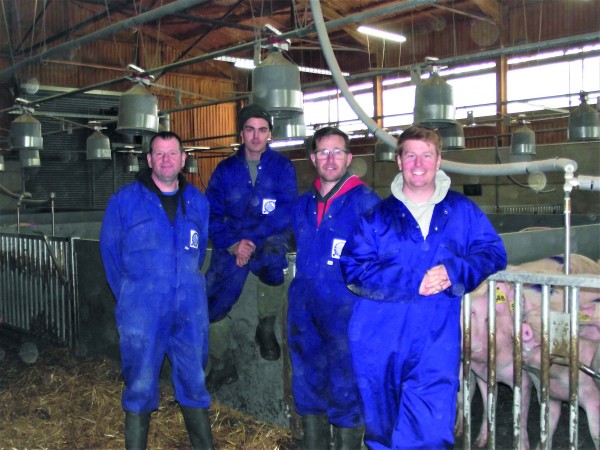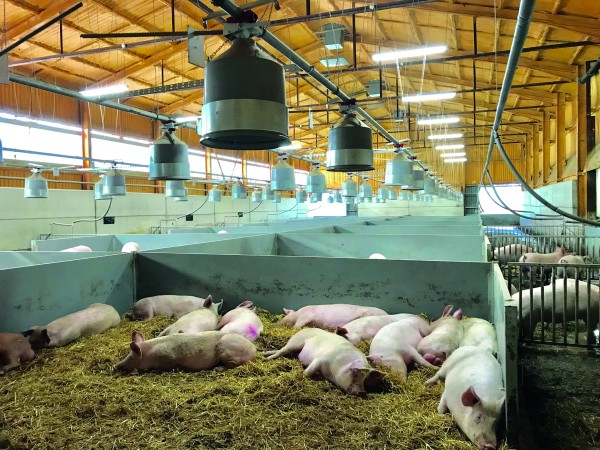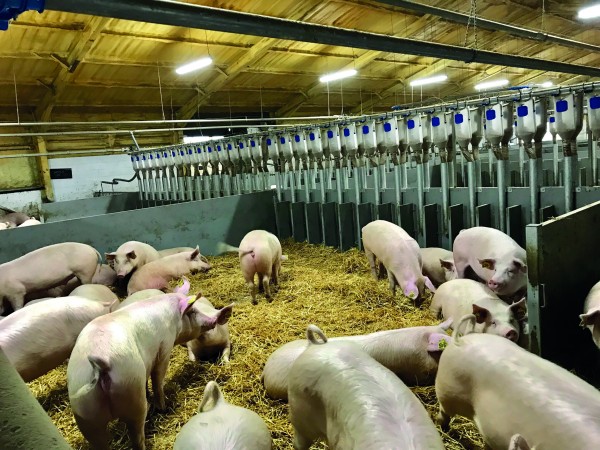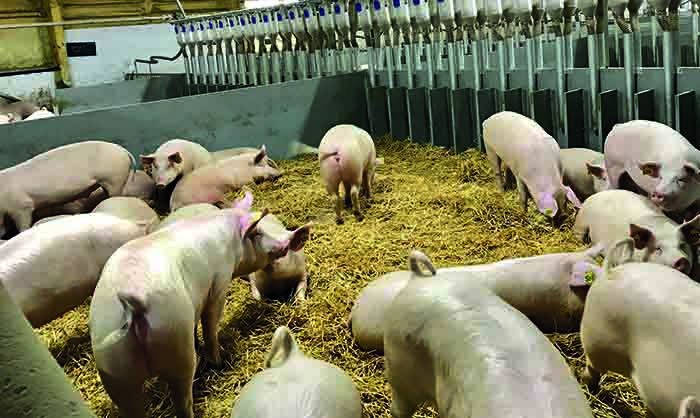Rattlerow Farms, named NPA AIG Member of the Year at the 2018 National Pig Awards, has expanded its gilt replacement options with the addition of a second specialised gilt mating unit. Jane Jordan reports on the visionary development
Progressive innovation and an innate understanding of commercial production has earned genetics company Rattlerow Farms much-deserved industry recognition.
Named NPA AIG Member of the Year in 2018, the company is well-respected for its pioneering, practically focused approach and continuous investment in breeding technology, training and knowledge transfer.

During its 66-year history, Rattlerow has introduced many efficiency-driven, commercially focused concepts to the UK pig sector and its latest investment, a second specialised gilt mating unit (GMU) in Cambridgeshire, is another visionary development.
The new GMU came on stream earlier this year and is already making an impact. It has improved economics for a number of restocks, enabling herds to get back into production sooner and release land previously used for gilt rearing/service to allow for herd expansion. The GMU-linked sourcing option is also encouraging some units to realign their replacement policies and re-examine the merits of regular repopulation within their health/genetic improvement plans.
Choosing ‘professionally’ reared in-pig gilts also guarantees that every female delivered to the farm is pregnant and prepared for a productive life – valuable assurance for producers as they sit tight and wait for their investment to bear fruit.
“Our focus is to help customers improve efficiency and increase profit potential. Expanding GMU activities fits that remit. We’ve seen how it has benefited our pyramid and the ones we manage for key customers, and we’re certain other herds could benefit from sourcing gilts this way,” said Simon Guise, Rattlerow Farms’s UK sales manager.
In simple terms, the GMU-linked concept entrusts the genetics supplier to manage the entire gilt rearing and mating process, and in Rattlerow’s case, to then deliver quality assured, professionally produced replacement females that are guaranteed 10 weeks in-pig, to a breeding herd.
It’s a highly successful formula and producers that have chosen to source GMU-produced gilts continually report farrowing rates of 98-99% for first litters with exceptional litter qualities and successful re-breeding outcomes post-weaning. Subsequent results, in terms of fertility and ongoing reproductive performance, are also commendable.
“We’ve found a GMU-sourced replacement plan can help improve litter performance in gilts and productivity is generally sustained into the next breeding cycle,” said Nick Lawson, Rattlerow’s general manager.
Much of AHDB’s current Gilt Watch initiative is targeted at reducing loss in parity 1 and 2 females, as statistics still show high cull rates in early life, with reproductive failure a principal factor. Some meaningful progress is being made, but feedback from commercial herds still suggests gilt rearing is fundamentally flawed.
“Producing good quality replacements, whether they are maidens or in-pig gilts, is a specialist job,” said Adrian Scarfe, Rattlerow’s production manager.. “The rearing objectives for breeding gilts are not the same as those for finishers. Growth must be controlled – the right diet is vital and specific targets for body weight at a given age must be achieved in the lead up to that critical first oestrus mating. Fortunately, that message appears to be filtering through to industry.”
Both Adrian and Nick have been working closely with specific customers during the past six months to repopulate some sites and reorganise gilt supplies. Monitoring outcomes on herds that have chosen the GMU-linked option has proved quite satisfying, as sourcing replacements from the GMU has enabled a more single-minded approach to pre-service management, which has helped to raise performance.
“The gilts now coming into these herds are more uniform in size and body condition, and the batches are very settled, too. Farrowing rates in the first parity are 98% and ‘not-in- pigs’ have been eliminated, which has helped productivity. They’re seeing good numbers born and reared with very few issues in subsequent cycles,” said Mr Scarfe.

BLUEPRINT ORIGINS BRING BENCHMARKED SUCCESS
The GMU concept has been part of Rattlerow’s dam line strategy since the late 1990s, which culminated in the development of a dedicated production site in Norfolk five years ago. This unit has a pivotal role producing in-pig gilts for Wayland Farms, although the methods used here have become a blueprint for gilt rearing and pre-service preparation across Rattlerow’s production base. The accommodation, management routines, nutritional programmes and production objectives are well-honed, with proven results at multiplication and commercial level.
“So much of a herd’s reproductive success rests on gilt management and how these young females are set up. How they’re matured, fed, housed and managed, through to that first mating impacts on subsequent performance,” said Mr Scarfe.
Standardised management is evident at the Cambridgeshire GMU, with pre- and post-service facilities similar to those used a the Norfolk GMU. Gilts are housed in straw- based, naturally ventilated yards with trickle dump feeding systems and the unit has a specifically designed AI pod offering copious strategic boar contact.
The heat detection, mating and service procedures are the same, too. The only difference here is that gilts are supplied pre-selected at 100-110kg liveweight from a dedicated multiplication unit, whereas the Norfolk site takes 7kg weaners.

On arrival, gilts are grouped in batches and run with a vasectomised boar to stimulate cycling. They are fed a restricted diet, grown on slowly for four weeks to 125kg and then move on to the synchronisation pens.
Here they are trickle-fed individually to administer Regumate. Stress is kept to a minimum.
It’s a calm environment, although this relaxed atmosphere belies the precision management needed for smooth running.
“Our standardised routine and purpose-built facilities mean it’s relatively easy to manage,” said Hadleigh Kirby, unit manager. He is a skilled technician with more than 16 years’ experience in Rattlerow’s nucleus herd and is enjoying his new role.
“We have to fit our production process around customer requirements and that dictates most of our activities. Record keeping is a priority, though, and we must know where every gilt is in the system,” he added.
Stockman Alistair Mulholland, who joined Rattlerow in October 2018, agrees.
“I like working with livestock, but hadn’t much experience with pigs, so I’ve trained
on the job on a number of Rattlerow’s units. The batch production process and structured approach to management has given me confidence to progress,” he said.
GMU – what it means for you
A GMU-linked replacement policy is a partnership. Producers must buy into the programme and agree to take ownership of their gilt consignment prior to first service.
Once allocated to a customer, these ‘purchased’ gilts undergo an oestrus synchronisation programme and the breeding process begins.
Once synchronised and on heat, the batch is served using Rattlerow’s proven AI protocols. Gilts are served at least twice with boar exposure controlled throughout. “Managing a dedicated GMU has helped us learn and refine our gilt rearing and management and service techniques – knowledge we’ve rolled out to other breeding units and customer farms. We’ve developed systems and facilities that optimise performance and we’re continually examining how to improve them,” said production manager Adrian Scarfe.
Once served, gilts are returned to straw yards and remain as a stable group. They are scanned at four weeks post-service to confirm pregnancy, with a further validation scan at week nine before they are transferred to customers at 10 weeks in-pig. Any ‘not-in-pig’ animals (NIPs) are removed.
On arrival at the breeding site, gilts usually remain in their gestation groups until they are moved to farrowing paddocks.




